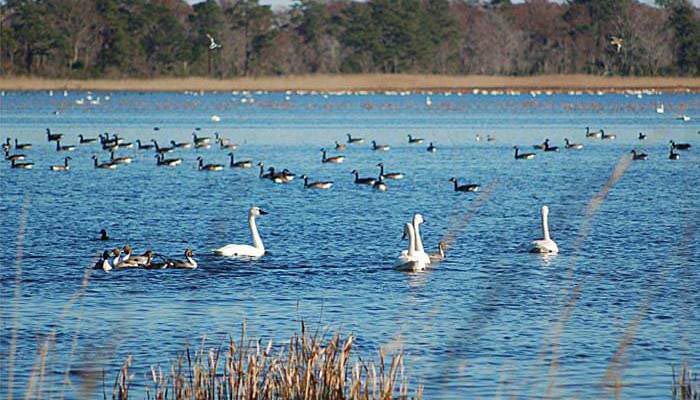Chilika Lake is the largest internal salt water lake in Asia, it is a paradise on earth for bird watchers and nature lovers. The pear-shaped lake is dotted with a few small islands and has fisheries and salt pans around its shore. The Chilika Lake also houses the most accommodating ecosystems in the world, which means that a wide assortment of flora and fauna can be spotted here. The lake offers a flamboyant display of a myriad of avian charms in all diverse hues and colours, ranging from the white-bellied sea eagles to flamingos, and from golden plovers to sandpiper
Along with the vibrant variety of birds: both native and migratory one, the enthralling lake also offers scenic views of sunrise and sunset and a host of other options to choose from. Attractions such as the Bird Island, Breakfast Island and Honeymoon Island are also frequented by tourists who visit the Chilika Lake. The lake also boasts of being one of the only two sites in the world where the endangered Irrawaddy dolphins can be spotted. The decent and affordable lodges available here are an added cherry on this already delightful cake. Visit this enchanting lake to spend a day in nature's company and experience tranquillity like never before.
Chilika Lake Bird Sanctuary
Since the lake is located on the east coast of India and has large water bodies, the place is a heaven for migratory and resident birds, and an equal delight for visitors, especially bird watchers, who stop by to have a look at these majestic creatures. The Chilika Lake Sanctuary is spread over an area of 1100 square kilometres and is home to a myriad of birds. This pear-shaped sanctuary is also one of the most visited sanctuaries in the state of Odisha. The Chilika Lake attracts an array of birds that choose this spot as their winter stopover, and come to visit this lake from as far as Iran, Siberia and Central Asia. The graylag geese, purple moorhen, flamingo, Brahminy Kite, spot-billed pelican, bar-headed goose, open-billed stork, pintail, king fisher, Egret, Avocet, gulls, tern, herons and white-bellied sea eagles are found here in large populations. In fact, the Chilika Bird Sanctuary is home to one of the largest breeding colonies of flamingos in the world.
Flora and Fauna at Chilika Lake
Other than these avifaunal species, the Chilika Lake also harbours a rich variety of wild animals, such as golden jackals, spotted deer, black buck and hyenas. The aquatic basin area houses over 225 species of fishes, including the well-known Chilka dolphin. Marine wildlife such as prawns and limbless lizards can also be spotted here. Apart from having a vibrant and dynamic variety of wildlife, the lake is also home to a healthy floral system that comprises of aquatic and non-aquatic plants. Visitors can spot rare and endangered species of all forms of flora here. In fact, it may interest you to know that the Chilika Lake is the most popular eco-tourism destination in the entire Odisha and is considered as a Ramsar site, because of the vast variety of endangered species that it provides shelter to.
Attractions at Chilika Lake
The lake offers a variety of different attractions that the tourists can explore to appreciate the beauty of nature in all its grandeur.
Bird Island : Ornithologists flock here in large numbers to witness birds in their natural habitat.
Nalabana : Nalabana is a huge island in the centre of the lake that gets completely submerged during the monsoon months. A designated bird sanctuary, the island is always full of the chirps of many resident birds and migratory visitors, who never fail to delight the onlooker.
Kalijai Island : Considered to be the abode of Goddess Kalijai, the temple that is located here has an interesting history to it. It is widely believed that a young girl named Kali, and her sister who later came here looking for her, were both drowned in this island and the residents vouch to have heard their cries. Upon the construction of a temple, the cries ceased, and since then, the place has had a significant religious value. The location is easily accessible via a boat from the Chilika Lake and is a must visit at the time of Makar Sankranti, when the Makar Mela takes place.
Satapada : The Satapada Island, bounded by the lagoon on three sides, attracts the visitors because it is home to the flagship species of the Chilika Lake, the Irrawaddy dolphins. This island is one of the only two lagoons in the world where this endangered species can now be found. Tourists can easily reach this spot via boats arranged by OTDC.
Best Time To Visit Chilika Lake
Undoubtedly, the best time to visit the Chilika Lake is the winter months of November to February, when the variety of migratory birds can be witnessed. In case you wish to visit the place at some other time, avoid the rainy season from June to September.
How to Reach Chilika Lake
The nearest airport to the Chilika Lake is Bhubaneswar, which is about 120 kilometres away. OTDC tour buses, state buses and other private operators frequently ply between Chilika and Bhubaneswar. The nearest railway stations are Rambha and Balugaon. From both these stations, buses and auto rickshaws are easily available to Chilika.

